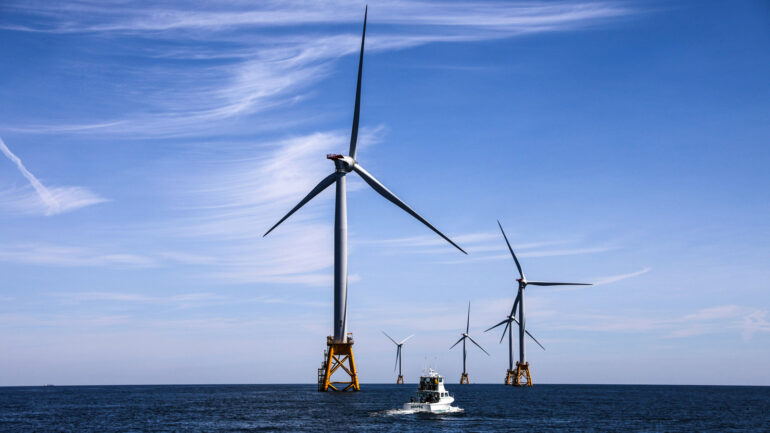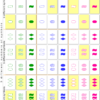On a breezy, sunny day in May 2022, the state of California broke a record—cleanly. For just a few minutes, the state exceeded its massive consumer electricity needs, using only the power of renewable energy. And yet, as the state set this remarkable record, natural gas power plants still hummed in the background, a reminder that, despite the massive progress the state has made investing in renewable energy, more work must be done.
California is the second most-energy-using state in the United States, the fifth largest economy in the world, and a renewable energy pioneer, setting a goal of transitioning to 100% clean retail electricity by 2045. Now, to power its communities and economy—and break even more records—it is looking to its famously long (840-mile) coastline. Soon, two new offshore wind energy areas could provide bountiful clean energy to the state; the new floating wind farms will also help the entire country move closer to the Biden administration’s goal of reaching 30 gigawatts of offshore wind energy by 2030 and carbon-pollution-free energy by 2035.
In a first for the West Coast, which required novel analyses of floating wind turbines, researchers at the National Renewable Energy Laboratory (NREL) have assessed the best way to divide up these offshore wind energy areas into individual leasing areas. The evaluation, published in a technical report, will inform the U.S. Department of the Interior’s Bureau of Ocean Energy Management (BOEM), which will make the final decision and plans to auction the sites to floating wind farm developers soon.
“As the first offshore wind leases on the West Coast, Humboldt and Morro Bay will open up access to a new resource that could be a valuable complement to other renewable power generation sources in California,” said NREL researcher and the lead author of the report, Aubryn Cooperman. “Wind power plants in these areas could be among the first commercial-scale floating wind power plants in the world, leading the deployment of new technology that has potential to deliver clean energy to coastal regions worldwide.”
Areas off the coast of Morro Bay, located about halfway between San Francisco and Los Angeles, and Humboldt, near California’s northern border with Oregon, were designated as wind energy areas in 2021. Offshore wind leases in these two areas (anticipated to be auctioned this fall) will be the first in California—and the entire West Coast. NREL’s analysis of delineation options builds on recent NREL studies that analyzed the wind resource and cost of offshore wind energy in various areas along the California coast, including Humboldt and Morro Bay. NREL has also partnered with Cal Poly Humboldt to look at transmission constraints and possible solutions in the Humboldt region.
Setting their sites offshore
First, the NREL team had to consider physical aspects of the locations, such as:
Size of the areaWind speed and directionOcean depthSeafloor terrainDistance from shorePotential for hazards, such as tsunamis or underwater mudslides.
The waters deepen quickly off the West Coast, which creates additional challenges for offshore wind energy developers compared to the East Coast. Foundations rigidly attached to the seafloor are impractical in deep waters.
That is why NREL continues to research ways to improve existing and develop new offshore wind energy technology, including floating wind turbine mooring lines and anchors, which keep the turbine in place.
“Wind turbines tend to be sited farther from shore where they are less visible, but that puts them in deeper waters. That’s why the development of floating offshore wind energy technology is so important,” said Walt Musial, a report co-author and the NREL offshore wind energy research lead.
Swimming in deeper waters
The team also looked at what might impact the amount of energy each power plant could generate, including mooring arrangements and wake effects within the wind plant and from the presence of other wind plants. Different delineations of the leasing areas and turbine layout configurations could increase or decrease the amount of wind energy sent back to shore.
They evaluated different options for how far wind turbines could be spaced apart based on:
Wind turbine sizesMooring systemsWake effects between wind turbines.
Wake effects refer to the disturbed airflow behind a wind turbine, potentially limiting the amount of energy a turbine downwind receives and therefore the amount of electricity that the blocked turbine can produce. Situating several wind power plants near each other can cause energy losses for plants downwind from another. To compensate for these effects, the team recommended adjustments to the sizes of potential lease areas within each wind energy area so that, in cases where one potential lease area was downwind from another, the downwind site was enlarged.
The mooring systems of floating wind turbines create a unique problem for wind farms in deep water. Depending on the type of mooring used, the distance between the wind turbines and the boundary of the lease area may need to be larger—a key part of the analysis. Developers will have to face a trade-off between fitting more turbines into their lease area (for more power generation), which may require more expensive moorings, or accepting a cheaper, larger mooring footprint, which means leaving some of their lease area empty of turbines.
Powering up the Pacific
The team proposed two options for the Humboldt wind energy area. In both options, under most wind-turbine-spacing possibilities, the team envisioned each developer installing a wind power plant with a capacity close to 1 gigawatt in each section. Once developers get their wind power plants up and running, that could supply somewhere around 1.5–3 gigawatts of clean, renewable energy to the U.S. grid.
The four options the team proposed for Morro Bay, again assuming wind power plant capacities around 1 gigawatt in each of the sections within the area, could generate 3–5 gigawatts of energy.
Previous NREL reports helped inform BOEM’s first commercial leases for offshore wind energy on the East Coast. With the help of this new report, wind farm developers could be holding the first leases on the West Coast before the year ends. These areas alone could power over 1.5 million homes—contributing over 10% of the nation’s offshore wind energy goal.
BOEM and NREL will continue to evaluate other offshore areas to grow the United States’ offshore wind energy sources, including other locations along the West Coast and in the Gulf of Mexico.
“We are excited to continue to work with BOEM to identify opportunities for clean energy generation from the vast resources in U.S. waters,” Cooperman said.
Soon, wind turbines may be sharing those breezy California waters, making it clear just how powerful they are.
Provided by
National Renewable Energy Laboratory
Citation:
Plugging into offshore wind will power up California’s renewable energy (2022, May 30)



